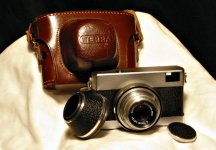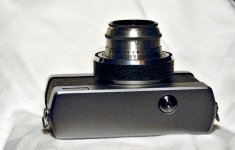You are using an out of date browser. It may not display this or other websites correctly.
You should upgrade or use an alternative browser.
You should upgrade or use an alternative browser.
which werra model?
- Thread starter back alley
- Start date
- Latest activity Latest activity:
- Replies 18
- Views 3K
jlw
Rangefinder camera pedant
You've got a Werra I, made by Carl Zeiss Jena circa 1955. I know it's a I because it has a simple optical viewfinder and no meter; you'll probably be annoyed to know that there also were a Werra II, with framelinedand meter, and a Werra III and IV which had coupled rangefinders and interchangeable lenses; the III was meterless and the IV had the meter
They also were available with the leatherette either in black, like yours, or olive drab. Which shutter does yours have? Some came with Compur-Rapid or Synchro Compur, but you'll also see them with Soviet-bloc East German Prestor RVS shutters; the latter can be distinguished by the shutter's 1/750 top speed, a trick achieved by using double-ended blades that only had to rotate in a single direction rather than opening, reversing and closing as with a normal leaf shutter. (Brilliant Marxist ingenuity? Maybe, but the Kodak Synchro-Rapid 800 shutter worked on the same principle.)
Nice for you is that your camera appears to be in very nice condition, the Tessar lens should make nice sharp pictures, and your Werra came with its neat reversible lens hood/shield that protects the lens and shutter mechanism when screwed big-end-first into the cocking ring surrounding the shutter mechanism.
And before you kick yourself too much for not having snared one of the RF-coupled models, keep in mind that their rangefinders are curious split-image-only items somewhat like the one found in the Soviet Leningrad -- the central rangefinder spot is NOT semitransparent, it's opaque and shows only the view through the tiny RF window. The system is bright, all right, and the rangefinder patch is nicely defined, but since you can't see coincident images, you can only focus accurately on objects having well-defined vertical lines! It doesn't say so in my reference books, but I'll bet the framelines are like the Leningrad's, too -- black etched rather than white reflected or projected. I recall looking through a Werra at a camera show a few years ago and being impressed by the finder's brightness and clarity, but it's still a bit peculiar.
What's it worth? Sorry, no idea, but it says in my long-outdated McKeown book that the III and IV models are fairly common in Germany, less so in the US. There's an olive Model IV from Slovakia currently languishing on eBay under a $90 starting price with no bids, but its condition doesn't appear to be as nice as the one you've got, and there's a lot to be said for the purity of the uncluttered Werra I even if it's not a rangefinder camera!
They also were available with the leatherette either in black, like yours, or olive drab. Which shutter does yours have? Some came with Compur-Rapid or Synchro Compur, but you'll also see them with Soviet-bloc East German Prestor RVS shutters; the latter can be distinguished by the shutter's 1/750 top speed, a trick achieved by using double-ended blades that only had to rotate in a single direction rather than opening, reversing and closing as with a normal leaf shutter. (Brilliant Marxist ingenuity? Maybe, but the Kodak Synchro-Rapid 800 shutter worked on the same principle.)
Nice for you is that your camera appears to be in very nice condition, the Tessar lens should make nice sharp pictures, and your Werra came with its neat reversible lens hood/shield that protects the lens and shutter mechanism when screwed big-end-first into the cocking ring surrounding the shutter mechanism.
And before you kick yourself too much for not having snared one of the RF-coupled models, keep in mind that their rangefinders are curious split-image-only items somewhat like the one found in the Soviet Leningrad -- the central rangefinder spot is NOT semitransparent, it's opaque and shows only the view through the tiny RF window. The system is bright, all right, and the rangefinder patch is nicely defined, but since you can't see coincident images, you can only focus accurately on objects having well-defined vertical lines! It doesn't say so in my reference books, but I'll bet the framelines are like the Leningrad's, too -- black etched rather than white reflected or projected. I recall looking through a Werra at a camera show a few years ago and being impressed by the finder's brightness and clarity, but it's still a bit peculiar.
What's it worth? Sorry, no idea, but it says in my long-outdated McKeown book that the III and IV models are fairly common in Germany, less so in the US. There's an olive Model IV from Slovakia currently languishing on eBay under a $90 starting price with no bids, but its condition doesn't appear to be as nice as the one you've got, and there's a lot to be said for the purity of the uncluttered Werra I even if it's not a rangefinder camera!
dazedgonebye
Veteran
What you really need is a WerraMatic...like the one I have for sale in the classifieds rght now.
Pics of and from that camera: http://www.flickr.com/photos/stevemphoto/sets/72157594322049712/
Pics of and from that camera: http://www.flickr.com/photos/stevemphoto/sets/72157594322049712/
dazedgonebye
Veteran
back alley
IMAGES
this was a gift from a friend by way of goodwill. she said she saw it and thought i might like it.
i cannot tell which shutter it has or what shutter speeds for that matter.
there is little info, it does say werra on the back in the leatherette. identifies the lens as a carl zeiss jena, tessar 50/2.8. looks like a scale focus. has a film counter on the bottom and seems to load the film from the reverse from normal side. finder is a bit cloudy.
i've never used it.
i cannot tell which shutter it has or what shutter speeds for that matter.
there is little info, it does say werra on the back in the leatherette. identifies the lens as a carl zeiss jena, tessar 50/2.8. looks like a scale focus. has a film counter on the bottom and seems to load the film from the reverse from normal side. finder is a bit cloudy.
i've never used it.
jlw
Rangefinder camera pedant
Yes, the lens is scale focus, the frame counter is on the bottom, and film advance/shutter cocking is by twisting the textured ring around the lens housing.
As to why you can't tell what the shutter speed range is... I'm not sure, but I think the scale ring is missing! The pictures I have in books show the speed ring as being parallel to the camera front, just inside the textured cocking ring, as on this Werra pictured on http://www.geocities.com/jagpage/werra.html:

If the speed scale is missing, though, it must be a common failing, because here's a picture of another one like yours, from www.amdmacpherson.com/classiccameras/

If you're familiar with the musical Guys and Dolls, maybe the shutter speeds on a Werra are like the spots on Big Julie's dice: You just remember where they are!
As to why you can't tell what the shutter speed range is... I'm not sure, but I think the scale ring is missing! The pictures I have in books show the speed ring as being parallel to the camera front, just inside the textured cocking ring, as on this Werra pictured on http://www.geocities.com/jagpage/werra.html:

If the speed scale is missing, though, it must be a common failing, because here's a picture of another one like yours, from www.amdmacpherson.com/classiccameras/

If you're familiar with the musical Guys and Dolls, maybe the shutter speeds on a Werra are like the spots on Big Julie's dice: You just remember where they are!
back alley
IMAGES
good lord, it was right there in front of me.
b to 250
joe
b to 250
joe
jlw
Rangefinder camera pedant
If the top speed is 1/250, then according to the profile on www.amdmacpherson.com/classiccameras/ it must be one of the earlier models with the Vebur shutter. Odd that they would use a more limited shutter and still go to the expense of installing the Tessar lens... oh, well, this was Carl Zeiss (Jena) and their model structure wasn't always based totally on logic!
I'll bet it's a really good picture-taker, if everything works and if you use it within its limits.
I'll bet it's a really good picture-taker, if everything works and if you use it within its limits.
rxmd
May contain traces of nut
If you want to delve into the wide and bottomless field of peculiar East German cameras, I can recommend starting with the Belmira (link).
Coupled rangefinder, good Tessar 2,8/50 lens, leaf shutter, finder on the wrong (that is, right) side, advance lever actuated with the left (!) hand, and all that in a package with exceptionally clean design from 1958 or so. And to top it all, look at the weird shape of the rangefinder patch. 😉
Coupled rangefinder, good Tessar 2,8/50 lens, leaf shutter, finder on the wrong (that is, right) side, advance lever actuated with the left (!) hand, and all that in a package with exceptionally clean design from 1958 or so. And to top it all, look at the weird shape of the rangefinder patch. 😉
dazedgonebye
Veteran
Amazingly clean looking, isn't it? Scale focusing 50mm is a bit scarey though.
back alley
IMAGES
not too i bad, i think.
i'll have to put some film in it soon.
joe
i'll have to put some film in it soon.
joe
RdEoSg
Well-known
We just got a Werra II I think it must be. It has the rangefinder and Meter, but has a fixed lens. Slow speeds seem to be out unfortunately but I think I will give it a nice home on my desk anyways! It sure is a cool looking camera!
back alley
IMAGES
yes, very cool looking art deco...
dazedgonebye
Veteran
Did I mention I have a nice werra kit for sale in the classifieds?
🙂
🙂
P
pshinkaw
Guest
I have one just like yours, but not as shiny and new looking. I paid $35 plus shipping on e-Bay and thought it was a bargain. At the time (4 years ago) most of them were selling for between $50-75.
With film in them, they feel a little tight, almost like they are on the verge of breaking. Seem to be pretty tough though.
-Paul
With film in them, they feel a little tight, almost like they are on the verge of breaking. Seem to be pretty tough though.
-Paul
RdEoSg
Well-known
It is now sitting pretty on the top of my desk!
Krg
Newbie
My Werra collection:
My Werra collection:
See your model on my french web page:
http://perso.orange.fr/krg/werra/werra.htm
A Werra forum:
http://groups.yahoo.com/group/WerraGroup/
My Werra collection:
See your model on my french web page:
http://perso.orange.fr/krg/werra/werra.htm
A Werra forum:
http://groups.yahoo.com/group/WerraGroup/
Similar threads
- Replies
- 5
- Views
- 215
- Replies
- 2
- Views
- 455
- Replies
- 2
- Views
- 118
- Replies
- 4
- Views
- 585
- Replies
- 11
- Views
- 882



